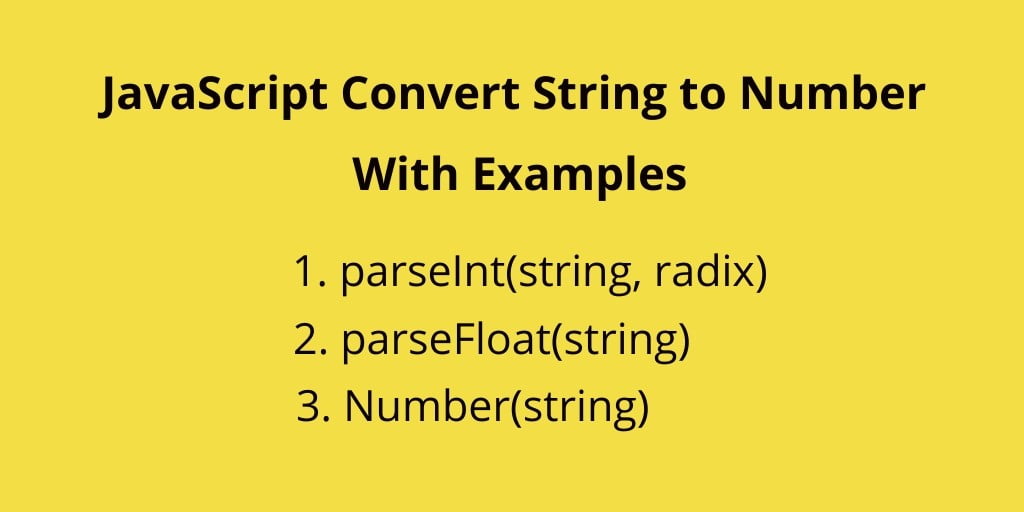
Validity: Definitions, aliases, and validity information for Unicode locales, languages, scripts, regions, and extensions,…ĬLDR uses the XML format provided by UTS #35: Unicode Locale Data Markup Language (LDML). Language & script information: characters used plural cases gender of lists capitalization rules for sorting & searching writing direction transliteration rules rules for spelling out numbers rules for segmenting text into graphemes, words, and sentences keyboard layouts…Ĭountry information: language usage, currency information, calendar preference, week conventions,… Translations of names: languages, scripts, countries and regions, currencies, eras, months, weekdays, day periods, time zones, cities, and time units, emoji characters and sequences (and search keywords),… Locale-specific patterns for formatting and parsing: dates, times, timezones, numbers and currency values, measurement units,…
#Js convert string to number software#
This data is used by a wide spectrum of companies for their software internationalization and localization, adapting software to the conventions of different languages for such common software tasks.

In my case, * 1 is the winner performance-wise 10x faster than other alternatives.The Unicode Common Locale Data Repository (CLDR) provides key building blocks for software to support the world's languages, with the largest and most extensive standard repository of locale data available.

Generally one of the fastest options, behaves like the + unary operator, so it does not perform conversion to an integer if the number is a float.

Similar to the + unary operator, but returns the integer part, is to use Math.floor(): Math. See how it returns NaN in the first example, which is the correct behavior: it’s not a number. Its parseInt() sibling, it only takes one argument – the string to convert: parseFloat ( '10,000' ) //10 ❌ parseFloat ( '10.00' ) //10 ✅ (considered decimals, cut) parseFloat ( '10.000' ) //10 ✅ (considered decimals, cut) parseFloat ( '10.20' ) //10.2 ✅ (considered decimals) parseFloat ( '10.81' ) //10.81 ✅ (considered decimals) parseFloat ( '10000' ) //10000 ✅ Use + If you want to retain the decimal part and not just get the integer part, use parseFloat(). ParseInt() tries to get a number from a string that does not only contain a number: parseInt ( '10 lions', 10 ) //10īut if the string does not start with a number, you’ll get NaN (Not a Number): parseInt ( "I'm 10", 10 ) //NaNĪlso, just like Number it’s not reliable with separators between the digits: parseInt ( '10,000', 10 ) //10 ❌ parseInt ( '10.00', 10 ) //10 ✅ (considered decimals, cut) parseInt ( '10.000', 10 ) //10 ✅ (considered decimals, cut) parseInt ( '10.20', 10 ) //10 ✅ (considered decimals, cut) parseInt ( '10.81', 10 ) //10 ✅ (considered decimals, cut) parseInt ( '10000', 10 ) //10000 ✅ Other solutions Use parseInt() and parseFloat()Īnother good solution for integers is to call the parseInt() function: const count = parseInt ( '1234', 10 ) //1234ĭon’t forget the second parameter, which is the radix, always 10 for decimal numbers, or the conversion might try to guess the radix and give unexpected results. In the case you need to parse a string with decimal separators, use Intl.NumberFormat instead. If we use the constructor ( new Number("1234")) it returns us a Number object instead of a number value, so pay attention. Number is a wrapper object that can perform many operations. The best one in my opinion is to use the Number object, in a non-constructor context (without the new keyword): const count = Number ( '1234' ) //1234 JavaScript provides various ways to convert a string value into a number.

#Js convert string to number how to#
Learn how to convert a string to a number using JavaScript


 0 kommentar(er)
0 kommentar(er)
